

A global archive of independent reviews of everything happening from the beginning of the millennium
Read our Copyright Notice click here
For publication dates click here
The Monument
 Cathedral, Monaco-Ville
Cathedral, Monaco-Ville

 Notre Dame du Puy Cathedral, Grasse
Notre Dame du Puy Cathedral, Grasse
The cathedral in Monaco is home to the annual organ festival and the cathedral in Grasse has a 1855 organ with an ongoing restoration appeal but in 2022 I did not get to hear a recital in either.

 Notre Dame de France, Leicester Place,
London
Notre Dame de France, Leicester Place,
London
 pinnacles
pinnacles


 The Monument
with St Magnus Martyr in the distance
The Monument
with St Magnus Martyr in the distance
MONUMENTS 2022
Reviewed by ANDRE BEAUMONT
Any historic or grand building can count as a monument. The difference with this review is that a bit of music will take place within or outside it.
Tourism really. No necessity on the reviewer to be incisive about the music; if needs be that can be about the monuments.
It starts at the Monument.
It hardly seems possible nowadays to go to an organ recital without the Prime Minister's car coming the other way.
So coming out of Monument Underground station and making my way up King William Street to pass St Mary Woolnoth to get to St Margaret Lothbury, two churches on different sides of the Bank of England that share a vicar, there it was.
It was a Thursday and a little after midday but, no, interest rates did not go up. So just tourism.
St Margaret Lothbury
St Margaret Lothbury is a Grade I listed Wren church with a fine acoustic for its small organ built by George Pike England c.1801 and restored in 1984. I was told that a false canvas ceiling was installed by Wren, which is now painted blue.
It has lots of fine carved wood, brought from other Wren churches, some believed to be by Grinling Gibbons, and I am sure this adds positively to the acoustic for organ by breaking up and diffusing sound waves, as does the irregular oblong shape.
I visited twice, once sitting where there was wooden flooring beneath and another time where there were memorial stones. With the wood you did not also hear through the floor but on trying to hear external sounds as well I wondered if one sound was the Underground railway. My imagining probably.
With the stones beneath you did definitely also hear the organ through vibrations through the seats and stones, which added pleasantly to the auditory hearing.
I can see, or rather hear, why of all the City churches this one has a regular organ recital series.
Another is the organist, Richard Townend.
I would much rather organists be educative about the music and the organ played than the reviewer having to write about them as despite having listened to organ music much of a lifetime I have much to learn.
He fits the bill very well, giving a short interval talk with each recital, including those of visiting organists, and providing informative programmes.
The view from the threshold of the church - the Bank of England
Methodist Central Hall on Parliament Square is definitely a late Victorian monument, fulsome on the outside, a little less elaborate within.
Westminster Abbey with Methodist Central Hall on the left
Though I had been accustomed to hearing a Hill organ from an early age and knew that Hill organs were often found in town hall type buildings I was still surprised, to see this one with its 32 foot rank of pipes, rebuilt and with over 3500 pipes, in an unusual hall.
The dome is said to be the second largest of its type in the world and parts of it appear to have fabric shielding. Some of the few oculi had blinds drawn, there were deep balconies and most of the floor was carpeted. This adds up to a lot of damping and an acoustic quite different from what you might find in a church, possibly unique if you listen for that kind of thing.
I attended a recital by Gerard Brooks, current president of the Royal College of Organists, on 16 January 2022.
He also fits the mould of educating his audience, explaining the pieces he played, which are all found on his very recent CD and played on the same organ.
If you compare his playing of Louis Vierne's Carillon de Westminster on that CD, which we heard live, with his recording of the same at St Ouen, Rouen you can hear the difference of acoustic.
It was good to hear the deep bass of the 32 foot pipes though there is limited reverberation and no resonance through the floor.
I particularly liked the Jeremiah Clarke Trumpet Voluntary played on Hill pipes.
The Church of Our Lady and English Martyrs in Cambridge is a monument.
It is often mistaken for part of the University as it the first monument you pass coming into the city from the station and it features prominently in the long vista in the other direction.
It is neo-Gothic and shows how far the Victorians got in recreating Gothic using off the shelf church architecture components that they manufactured. It has friendly volumes but it does not sound Gothic.
On the first day that coronavirus restrictions were effectively removed in England, 27 January 2022, I attended a concert by The Orlando Singers and a trio there.
The church, near an intersection, has an acoustic subject to extraneous sounds but I suspect that some part of the concert will still emerge as a recording or video.
You are best served by a soundpath direct and close and the string instruments of the trio were impressive as the players were set further forward.
All the music was of high quality and particularly charming in the choral work was O Vos Omnes, one of two premieres by John S Wilson, one of the members of The Orlando Singers, which we were treated to.
extract from programme
Next up was the real thing, in terms of Gothic and the monumental.
I attended vespers at Antwerp Cathedral.

At 404 feet high it was for centuries the tallest building in the low countries. It has been a long time favourite of mine.
That it dominated the landscape and imagination is celebrated in the fictional story of Nello and Patrasche, which has got a new sculpture outside the cathedral.

I have not been too lucky with my revisting of Gothic cathedrals. My visit to Notre-Dame found it enveloped in scaffolding for obvious reasons and at Antwerp, more simply, for renovations.

At least I got a good view whilst dining nearby.
Inside, I come for the Rubens but the architecture, like Antwerp's diamonds, is not exactly a miss.
Without scaffolding, the tower is a unique wonder of the world.
This time, I came determined to hear at least one of the organs.

The Metzler organ and The Descent from the Cross triptych
The cathedral has two organs, the recently restored Schyven organ and the 1993 Metzler organ.
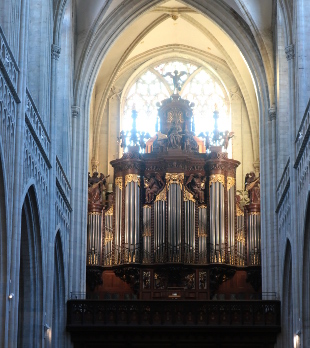
The Schyven organ

The Metzler organ
Vespers was a single voice, rather than a full choir as at Westminster Cathedral, accompanied by the organ and this, unsurprisingly, did not stretch the Metzler.

However, the very short organ voluntary at the end started to do so and left me very impressed by both the organ and the acoustic from where I was sitting.

The proximity of the octagon to the Metzler contributes positively to the acoustic.
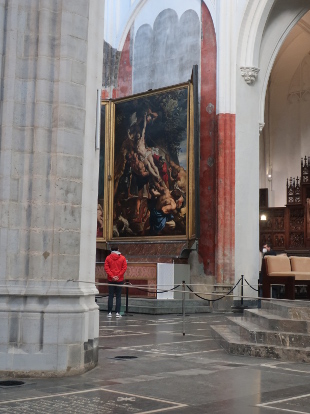
The centre panel of The Ascent of the Cross triptych
So the next place to go to was to the chapel at Trinity College, Cambridge, whose acoustic I have reviewed before, to listen to the Metzler organ again.

excerpt from TCMS programme
The accepted wisdom now, which is probably right, is that this is the organ to play baroque music on in Cambridge. However, from Colin Millington's recital, who also plays the saxophone and clarinet, I much enjoyed the Lennox Berkeley best and, at the end of the day, both these Metzlers are 20th century organs.

Playing this one, which is much the same size, would be great training for playing the Antwerp one so, Belgium, send us your budding organists, though the acoustic of the two places is much different.

Grade I listed Great Court from the door of the Chapel [1]
Next was to catch up on Queens' College where Queens' Graduate Choir and friends were giving a concert in an almost packed Chapel - very good to see as it is also out of term. This, too, was two years in the making because of the virus.
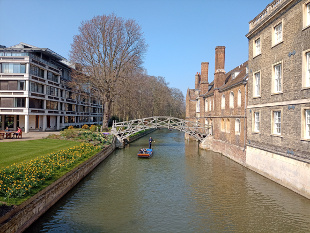
Queens' College and its Mathematical Bridge
A good space for music and lots of talent. It also had what was announced as the only live performance of William Hayes' Orpheus and Euridice in modern times. You cannot do better sometimes, than the type of music you get in College music societies.
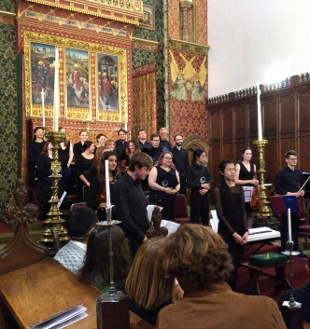

Having been to Antwerp Cathedral I made a visit to sit under the dome of St Paul's Cathedral for a service called Passiontide Organ Meditation - Stations of the Cross with organ music by Johann Sebastian Bach.

Here I was not unlucky at all with my cathedrals - that this magnificient monument was built in the seventeeth century so logically, well and quickly is a mark of the greatness of the nation, city and architect, something not yet paralleled this millennium, but it is not Gothic and there is no scaffolding.
The service was salutary in this, until recently unforseen, time of the return of war to Europe, which we must hope will end soon, but I can also see why Margaret Thatcher chose this cathedral for her post-Falklands conflict service. Buildings remind us more immediately of our history than history books, though they used to be full of Sir Christopher Wren.
In fairness, this was not an organ recital but a chorale and variations from BWV 768 and a passage from BWV 622 to conclude, interspersed into the service, all played by William Fox. The organ was not stretched except by the last variation, XI, but I can always return for an organ recital.

The organ, shrouded in incense
More intriguing from a musical point of view, I also attended, earlier the same day, an organ recital by Sebastian Heindl, visiting from Leipzig, in St James's Church, Sussex Gardens, which is near Hyde Park.
It is a Grade II listed Gothic Revival Church by G.E. Street, the architect of the Royal Courts of Justice, and it reminds of there in its creation of interior space in the Gothic style.

Having worked next door, familiar territory - entrance to the Royal Courts of Justice
It it the first G.E. Street church I have knowingly been in and so I was intrigued architecturally. Had a Leipzig organist been playing Bach I would have quickly got the measure of the organ, the acoustic and the organist but playing relatively unfamiliar pieces I am sufficiently intrigued to want to hear all three again.
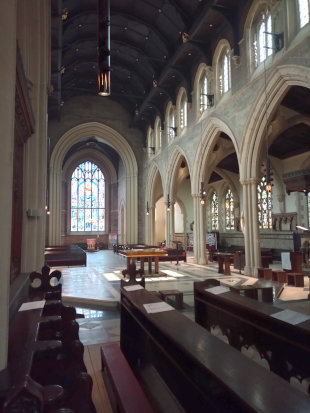
From the choir
Suffice to say that Sebastian Heindl is a good organist with a fluid, energetic style unlike the British ones.
He, too, explained what he was going to play.

First up was Camille Saint-Saëns' Danse Macabre, Op. 40 but to his own arrangement.
This was followed by César Franck's Grande Pièce Symphonique, Op.17, which played by him was a strikingly beautiful composition.

I remember as a student going up into the dome of St Paul's, onto its whispering gallery and down into the crypt whilst restoration was under way. When Sir Christopher Wren built it no dome of this scale had ever been attempted in the contemporary classical idiom. There were no structural engineers then but every architect has an eye for what will stand which is why so few buildings come down of their own accord and why, perhaps, you should not be substituting a surveyor or builder for an architect if you are after anything large or addressing aesthetics.
The structure proved to be massively overstructured with lots of redundant strength. We were told that the columns supporting the dome had been filled with a kind of concrete rubble that with the passage of time had settled removing its contribution to structural strength. Perhaps for centuries the encasing stonework of the columns had supported the dome but even they were significantly over-structured. Modern concrete materials were being inserted.
The acoustic of the space proved to be difficult for me to get a handle on during the organ recital. If you get close to quiet under the dome, sound travels with clarity but once it starts bouncing around from something quite different to an organ, like a public address speaker not set up, it sounds dreadful - more echo than clarity.
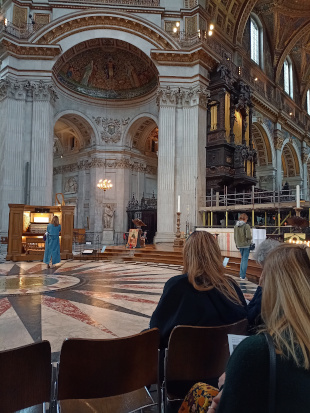
Line of sight to the organ console
The spaces beyond the dome must be complex for sound reflections but I could hardly wander round finding out.
Nor should this necessarily bother an organist who knows what he is doing.
As it happens this was the first of the Organ 150 celebrity organ series, the first series at St Paul's since 2019, and the organist was Johann Vexo, the choir organist of Notre-Dame who was playing when the fire started on the roof.
If you are forever playing for the choir you know how to get the sound right for the space.
So after the first piece I gave up trying to understand the acoustic from where I was sitting and settled into enjoying the music and the tune of the organ.

This was a true concert recital rather than a recital, all French pieces that hung together well as a concert, the Widor stretching the organ so getting me to understand that the way to overcome the great mix of architectural shapes and recesses reflecting sounds was to get everything reflecting and sounding at once.
You heard every which way, including reverberations through the floor and seats but in their case through a structurally very solid foundation not Gothic trembling, more Porsche chassis than MGB.
The Grande Pièce Symphonique was written by César Franck soon after he became organist at Sainte-Clotilde with its new Cavaillé-Coll organ. Having twice hear it in London within weeks I now need to hear it in Saint-Clotilde and Notre-Dame.
Louis Vierne's Symphony No.6 was written, the programme notes say, during a summer holiday in Menton.

Worthy of a mention is St Clement's Church in Cambridge. I arrived for a lecture not music but this church with a history going back to the 14th century has an interesting looking, presumably Victorian, organ. The church has been undergoing restoration and works recently, for which it has been partly funded by the National Heritage Memorial Fund, and I have often wandered by wondering what was going on.
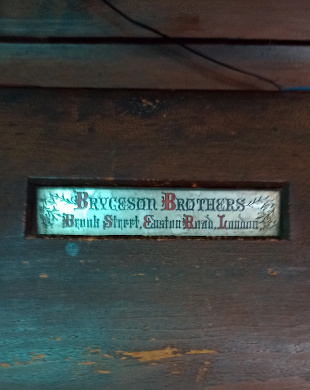
Organ maker
The Grade II* listed church took delivery of new bells a fortnight ago so this monument may literally sound like it has an interesting future. Should it get an acoustic review it might be from the outside.

Bell tower at St Botolph's
St Botolph's, Cambridge, like the university, has a history going back over 800 years.

It has acquired a Steinway grand piano and the inaugural concert will take place on 17 July 2022.
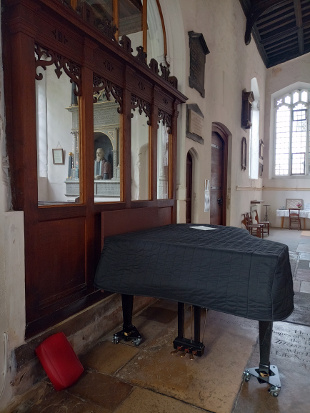
Another interesting future.

The brooding presence of Ely Cathedral in the Fens
I shall stick my neck out and say that of the church acoustics reviewed so far on this site Ely Cathedral has the best for organ music, at least seated under the unique Octagon. It is not the organ; it is the building.

A wide angle view of the Octagon from where I was seated for the recital
Romanesque and Gothic are better for it than neo-Gothic, Classical and Modern. An Octagon is better than a dome. Stone vaulted and triangulated ceilings better than barrel vaults and flat ceilings. Recesses of limited depth better than deep ones or balconies. A direct path out for sound better than relying solely on reflections.

The organ
The reverberation time was not too long or not too short. There was limited damping. Voices, footsteps and the sound of dropped items carried but not too much. After a hot summer's day the space was markedly cool, with no need, other than two open doors 30 yards away, of ventilation (and, happily, more importantly, no mislocated insulation, flammable or otherwise, keeping summer heat in) due to convection and copious air volume, excellent heat sink capacity of the fabric and no draughts, making for good air that carried sound properly.
(Buildings should, believe it or not, breathe naturally and not be airtight for optimum human health and good organ music. Otherwise you get sick building syndrome and, maybe, unhappy humans and organ pipes).
The floor carried mild vibrations but with no sense of instability - very good. Excellent natural illumination by sunlight as well so the only use of energy of note would have been to power the organ. Of 80 listed ranks there appear to be only three of 32 foot pipes so perhaps little opportunity to hear deep notes through the floor.

Glimpsed through the choir screen
The organist was the 34-year old American concert organist, Christoper Houlihan, who is listed as having played at St Pauls's in the Organ 150 series two days before.

Programme excerpt
I enjoyed the Esquisses which I had not heard before and the Liszt showed considerable character in the organist. I would happily listen to that again here.

The nave
This is the big cathedral in these flatlands around the Cambridgeshire/Suffolk border so Ely, a little town where you can take life slowly, is a city.
The limitation to hearing a recital from the edge of the octagon is that the organ is in the Choir. Thus much of the sound has to reflect out of the Choir.
I also attended on 28 August 2022 the greater part of a recital by Miriam Reveley, who is an assistant organist at the cathedral and who is also the Organ Scholar at St George's Chapel where she will play, in a little under an hour's time, the organ before the service for The Committal of Her Majesty Queen Elizabeth II.

KMSKA, Antwerp - medieval instruments - tromba marina (Marcel Snijders) and lute (Erwin Verdonck)
As it happens I am absolutely bursting with ideas about how museums can host music but let that roll.

The famous Antwerp hand, KMSKA, 3 October 2022
At the Royal Fine Arts Museum, KSMKA, for the recently completed building renovations that took 13 years, they appointed both an artist and an architect just for the mosaics.

On 1 November 2022 I went to a performance of Duruflé's Requiem for All Souls in Clare College Chapel which served as the mass in a service on the eve of All Souls. It was very well attended and thoroughly enjoyable.
The Chapel is neoclassical with a barrel vault and had a very good acoustic, for choir, soloists, solo instrument and organ though it stops short of being charismatic. The coffering, the shape of the space and the design of the modern organ all help.
The organ voluntaries, beginning and end, were Jehan Alain's Variations sur un thème de Clément Jannequin and Le jardin suspendu, the latter leaving me entranced as it suits the organ well. Senior and junior organ scholars are listed as Samuel Jones ans Daniel Blaze.

Today is the day of the Lord Mayor's Show and yesterday I went to an organ recital at St Stephen's Walbrook, in the lee of Charles Dance's Mansion House.

Sir Christopher Wren has made a spectacular domed interior space out of a fairly unornamented exterior.
Its plain but elegant flank would have got more prominence if the Mansion House Square project had gone ahead but, nonetheless, the open spaces in this quarter are of a generally high level of agreeableness, especially as it is an office area. Perhaps we should try to give more attention to space as well as buildings in other cities.

The central altar - there is one by Grinling Gibbons as well - is by Henry Moore. Of all the churches of this size in the City, this one has probably benefitted most from private benefaction in recent decades
The organist was Alexander Wilson who amongst other things is a Master's student of jazz saxophony at the nearby Guildhall School of Music. He gave an enjoyable recital but like quite a few classical churches there are architectural limitations on the acoustic of the organ. The melodic Boulanger probably suited this organ best.


Alexander Wilson is a prizewinning Fellow of the Royal College of Organists, pictured here

The Lord Mayor's car was waiting upon leaving but in fact he uses a state carriage for the processions.


The same day as the recital the new Lord Mayor succeeded his predecessor in advance of his procession. Four days later my luck held as the late London Mayor is a commercial lawyer and arbitrator and was at the same professional social event. (Five days later is the day of disappointment. No cat has told me to turn back.)
Since we have had three Prime Ministers and only two Lord Mayors during the duration of this review, six days later I attended a recital of the most famous living French organist, Daniel Roth, at Notre Dame de France in Leicester Place, a stone's throw from the City.
The venue is hosting a series to mark the bicentenary of the birth of César Franck.
Daniel Roth has been the Titular Organist of St Sulpice in Paris since 1985 and was a student of Marie-Claire Alain and Maurice Duruflé amongst others.

Programme excerpt
The church interior is a round domed space in neoclassic-influenced Modern. This makes for a very effective and excellently lit space for its function but it does have some consequences for the acoustic for organ.
For the first two pieces, which were a little quieter, seated facing the pipes the sound from the right pipes sounded aurally displaced about 70 degrees further to the right and reflected. Now you get reflected sound every which way from organs but this was a peculiarity of a round space. For the remaining pieces, which engaged more pipes, it was only noticeable in a few quieter passages.
The playing was marvellous so this was a true concert organist in a not quite organ concert venue.
At the end we were treated to an encore, "based on a traditional French melody", a fine improvisation for sure - Rule Britannia.
